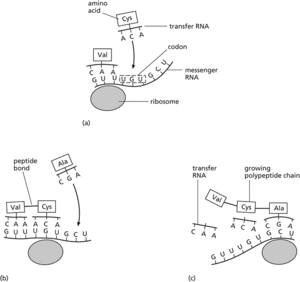Motion of a body in which all the points in the body follow parallel paths.
The movement of a spacecraft in any one direction along a straight line. This can include reversing.
See internetworking.
The process in living cells in which the genetic information encoded in messenger RNA (mRNA) in the form of a sequence of nucleotide triplets (codons) is translated into a sequence of amino acids in a polypeptide chain during protein synthesis (see illustration). Translation takes place on ribosomes in the cell cytoplasm. Initiation of the process involves the formation of an initiation complex and binding of the small ribosomal subunit to the mRNA (see initiation factor). In prokaryotes binding takes place at the Shine–Dalgarno sequence, whereas in eukaryotes the small subunit binds to the 5′ cap at the end of the mRNA molecule then moves to the start codon. The ribosome moves along the mRNA ‘reading’ each codon in turn. Molecules of transfer RNA (tRNA), each bearing a particular amino acid, are brought to their correct positions along the mRNA molecule: base pairing occurs between the bases of the codons and the complementary base triplets of tRNA (see anticodon; wobble). In this way amino acids are assembled in the correct sequence to form the polypeptide chain (see elongation). Translation is terminated at a stop codon, which binds a release factor. Several ribosomes can perform translation simultaneously on the same mRNA molecule (see polyribosome), thus increasing the rate of protein synthesis. Following their release from the ribosome, most assembled polypeptides undergo some form of chemical modification to produce a fully functional protein. These post-translational modifications can take place in the endoplasmic reticulum and might include cleavage of certain amino acids; cutting or joining of polypeptides; addition of sugars to form glycoproteins; or addition of phosphate groups.

The stages of translation in protein synthesis
See coiling.
The provision of an expression in one language meaning the same as that of another. In so far as different languages reflect different cultural and social histories, because of the holism of meaning, and because of the different associations and tone of different words, translation may be an ideal which can only be approached but never fully achieved. The thesis of the indeterminacy of radical translation goes beyond this by holding that radically different translations may be equally correct, thereby denying determinacy of meaning to the original expression. See also Sapir-Whorf hypothesis.
- halophyte
- halo population
- halotectonism
- halothane
- Halsell, James, Jr (1956– )
- Halsey, William Frederick (1882–1959)
- halt
- Halting problem
- halting problem
- Ham
- hamada
- Hamal
- Hamann, Johann Georg (1730–88)
- hamartia
- Hamas
- Hamblin’s axiom
- Hamel basis
- Hamilcar Barca (c.229)
- Hamilton, Alexander (1757–1804)
- Hamiltonian
- Hamiltonian cycle
- Hamiltonian graph
- Hamiltonian mechanics
- Hamilton, James, 3rd Marquis and 1st Duke of (1606–49)
- Hamilton, Sir William Rowan